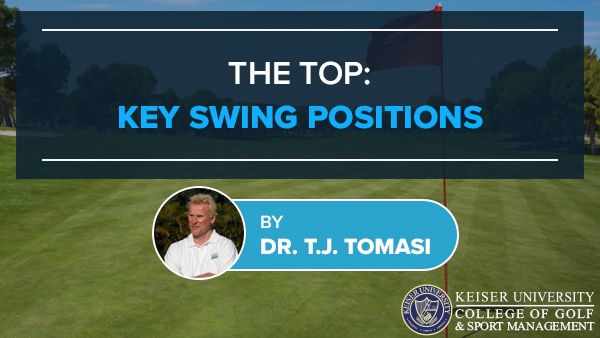The Top: Key Swing Positions

By Dr. T. J. Tomasi, Keiser University College of Golf Senior Faculty and Director of Research
This is a continuation of our series that isolates key swing positions so you can match your swing to the models to see how it stacks up.
The swing position dealt with here is the ‘position at the top.’ The model assumes a right-handed expert golfer hitting a predominately straight shot with a driver.
First, using a full-length mirror, swing to the top and pose in position based on the photo of the tour player below – this is what you should see: Your head in the center of the shoulders with the left shoulder under the chin and the right shoulder behind the neck. Ensure your hands extend away from your head so that your lead arm is angled across your chest. The shoulders have coiled – twice as much as the hips with the right knee flexed over the right foot and the left knee flexed and pointing toward the ball – both knees are level with one another. The club shaft with a longer club, such as the driver, is parallel with the heel line, whereas, with the shorter irons, the shaft does not reach parallel. The general rule is that the shorter the club, the shorter the swing. At the top, your lead hip is a bit lower than your trail hip, and your spine is tilted toward the target, with the weight favoring the rear foot about 80-20 – although this ratio can vary based on shot shape and body type.
The guiding theme here is COIL using a 2 to 1 ratio – 90 degrees with the shoulders via the spine torque and 45 degrees of a coil with the hips creating a ratio called the X FACTOR.

Notice the ripples in his shirt – these announce the presence of torque, which can be converted to power at impact if the downswing is correct.
The role of the backswing is to put the angles of power in place while also keeping the clubface square to the swing arc. As you become more proficient, you can add a repertoire of ball flights by varying setup, aim, alignment, etc.
Takeaway: Coil results from spine rotation primarily in the middle of your back in the thoracic spine. If you want to improve your coil, it will come by maximizing your flexibility in this region. Here is a drill to help you maximize this key position.
Drill: Take your address position using a driver, then put the club behind you so it lies across your shoulders [see photo.] Next, coil around your spine until your front shoulder is under your chin and your back shoulder is behind your head. This is a complete “two-shoulder turn” initiated and controlled by the thoracic spine torque.

Note: Do not put pressure on the shaft, or it might snap. You can use a broom in place of the club to protect the shaft if necessary. As always, check with your doctor before you do this.
Learn more!
Want more tips? If you want to take your game to the next level, contact our team at Keiser University’s College of Golf & Sport Management today. With our dedication and experience, together, we can elevate your game to new heights. Give us a call today at 888-355-4465.












